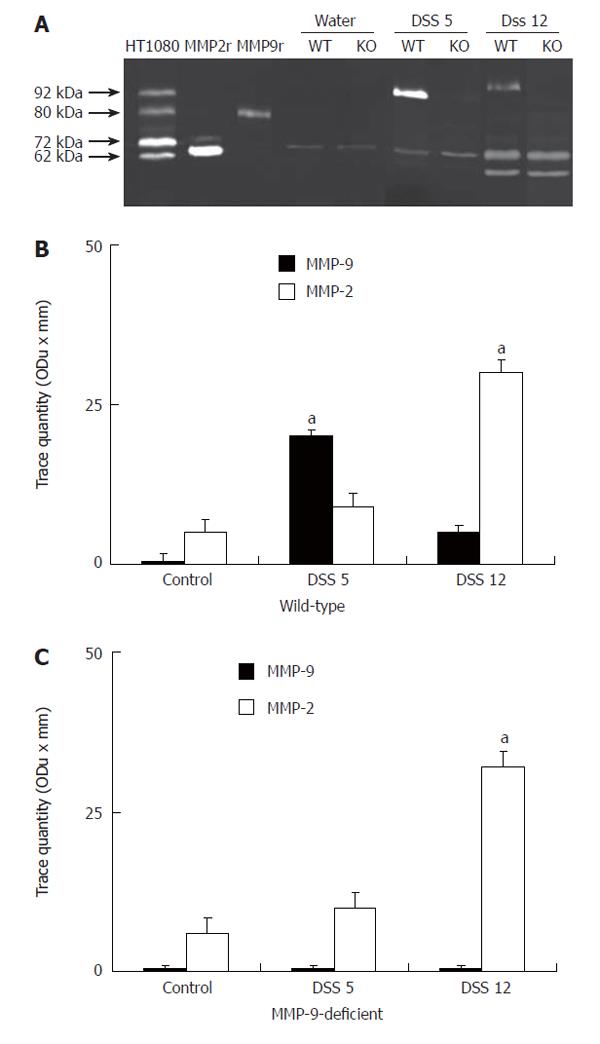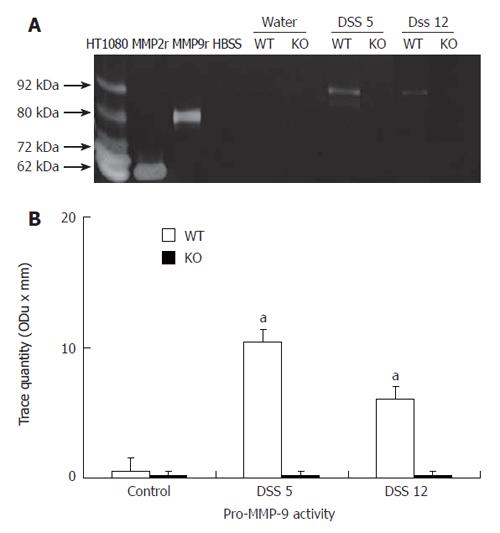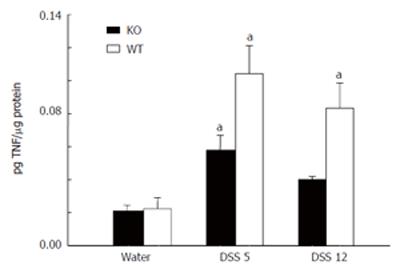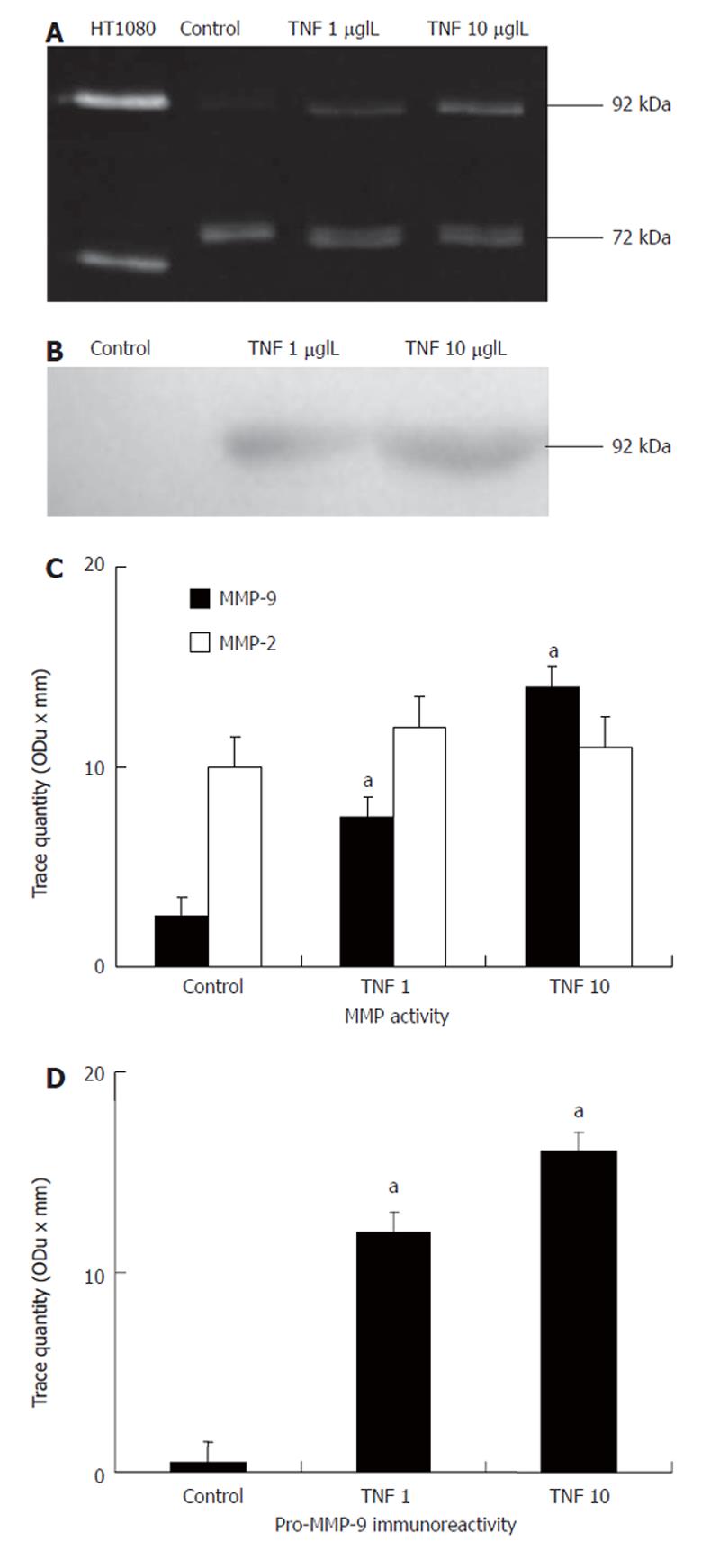Copyright
©2006 Baishideng Publishing Group Co.
World J Gastroenterol. Oct 28, 2006; 12(40): 6464-6472
Published online Oct 28, 2006. doi: 10.3748/wjg.v12.i40.6464
Published online Oct 28, 2006. doi: 10.3748/wjg.v12.i40.6464
Figure 1 Gelatinase activity in colonic homogenates.
A: Representative zymogram in wild-type (wt) and MMP-9-deficient (KO) animals on d 5 (DSS 5) and 12 (DSS 12) after induction of colitis (n = 9 in each group). Supernatant of HT1080 cells, human recombinants MMP-9 (rMMP9) and MMP-2 (rMMP2) were used as positive controls. Gelatinases with molecular weights of 62, 72 and 92 kDa corresponding to activated MMP-2, pro-MMP-2 and pro-MMP-9, respectively, were detected. Quantitative data of pro-MMP-9 and total MMP-2 (pro-MMP-2 and MMP-2) (aP < 0.05 vs control) in wt (B) and MMP-9-deficient mice (C).
Figure 2 Gelatinase Activity in purified Neutrophils.
A: Representative zymogram in wild-type (wt) and MMP-9-deficient (KO) animals on d 5 (DSS 5) and 12 (DSS 12) after induction of colitis (n = 15 in each group). Supernatant of HT1080 cells, human recombinants MMP-9 (rMMP9) and MMP-2 (rMMP2) were used as positive controls. HBSS was used as negative control. Pro-MMP-9 was detected in neutrophils from colitic wt animals; B: Quantitative data (aP < 0.05 vs controls).
Figure 3 Pro-MMP-9 immunoreactivity in colonic homogenates.
A: Representative immunoblot in wild-type (wt) and MMP-9-deficient (KO) (n = 9 in each group) animals on d 5 (DSS 5) and 12 (DSS 12) after colitis induction. Supernatant of HT1080 cells and human recombinants MMP-9 (rMMP9) were used as positive controls. A band of 92 kDa corresponding to pro-MMP-9 was detected in colitic samples. B: Quantitative analysis (aP < 0.05 vs control).
Figure 4 TIMP-1 activity in DSS-induced colitis: A: Representative reverse zymograms in homogenates of colonic tissue in wild-type (wt) and MMP-9-deficient (KO) animals on d 5 (DSS 5) and 12 (DSS 12) after induction of colitis; B: Quantitative data of TIMP-1 activity (aP < 0.
05 vs control) (n = 5 in each group); C: wt mice had a pro-MMP-9/TIMP-1 ratio significantly (aP < 0.05) higher than controls on d 5 (DSS 5) and 12 (DSS 12) following the induction of colitis. The pro-MMP9/TIMP-1 ratio was not modified by DSS-induced colitis in KO mice.
Figure 5 TNF-α content in colonic tissue.
Concentration of TNF-α protein in homogenates of colonic tissue from wild-type (wt) (n = 5) and deficient (KO) (n = 5) animals on d 5 (DSS 5) and 12 (DSS 12) after colitis induction (aP < 0.05 vs control).
Figure 6 Activity of gelatinases in Caco-2 cells in absence (control) or presence of TNF-α (1 μg/L or 10 μg/L).
A: Representative zymogram of gelatinases with molecular weights of 72 and 92 kDa corresponding to pro-MMP-2 and pro-MMP-9, respectively, were detected. Supernatants of HT1080 cells were used as controls. B: Representative immunoblot of pro-MMP-9 (92 kDa) protein in Caco-2 cells as above. C: Quantitative zymographic analysis (aP < 0.05 vs control). D: Quantitative western-blot analysis (aP < 0.05 vs control) (n = 3 in each group).
Figure 7 A: Percentage of body weight change during DSS-induced colitis in wild-type (WT) and deficient (KO) animals (n = 30 in each group).
Values are mean ± SE of percentage body weight change in each animal relative to weight at the start of DSS treatment. WT animals showed more weight loss than deficient mice (aP < 0.05). B: Survival curve of both colitic groups. The mortality was significantly higher in wt animals compared to deficient mice (aP = 0.015).
- Citation: Santana A, Medina C, Paz-Cabrera MC, Díaz-Gonzalez F, Farré E, Salas A, Radomski MW, Quintero E. Attenuation of dextran sodium sulphate induced colitis in matrix metalloproteinase-9 deficient mice. World J Gastroenterol 2006; 12(40): 6464-6472
- URL: https://www.wjgnet.com/1007-9327/full/v12/i40/6464.htm
- DOI: https://dx.doi.org/10.3748/wjg.v12.i40.6464















